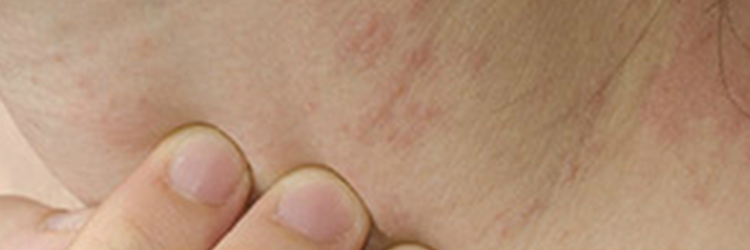Miliaria is a very common disorder seen during summer due to occlusion of sweat ducts. It often occurs in conditions of high humidity and temperature. Miliaria occurs due to the obstruction or disruption of eccrine sweat ducts. There are three clinical forms of miliaria due to the different levels of occlusion or disruption.
Miliaria crystallina (sudamina):
The word sudamia is derived from Latin- sudare means to sweat. It is formed as a result of obstruction within the stratum corneum and thus the vesicle is sub corneal. It is commonly seen in febrile illness associated with profuse sweating. It is also seen in infants due to the delay in opening up of eccrine ducts. Clinically presents as clear tiny vesicles without an erythematous background. The vesicles rupture easily and the area will desquamate.
Miliaria rubra (prickly heat):
It is formed due to the occlusion to the eccrine sweat duct in the living layers of the epidermis as it induces inflammation. The lesion manifest as erythematous papules over the friction prone areas, flexures and dorsum of hands and feet. This is the most common type of miliaria. It is seen commonly in hot and humid conditions, but sometimes seen even in desert regions. The symptoms of pricking and burning caused by extravasation of sweat containing lactic acid in to the epidermis, is relived partially by cool shower or air conditioning.
Miliaria profunda:
The word profunda means deep, occlusion of the eccrine duct is in the dermal layer. Commonly seen in the tropics following repeated bouts of miliaria rubra. Lesions are 1-3 mm diameter erythematous papule without many symptoms.
Common complications of miliaria are secondary bacterial infection and eczematisation.
Diabetics are more prone to develop miliaria and thus nonseasonal miliaria or extensive miliaria warrants investigating for diabetes mellitus.
Treatment:
Effective way of treating miliaria is by further reduction of sweating. The various treatments offered become ineffective if the sweating is not reduced. Calamine lotion, soothing lotions containing camphor and dusting powders containing starch may be useful. Anhydrous lanolin application is useful in the treatment of miliaria profunda. Oral vitamin C 1000 mg/day and antihistaminic are the common systemic treatment administered. Oral isotretinoin is also tried with variable results.
Title Golden sweat is apt because of the huge market to the prickly heat powders. With the global warming and surging temperature the incidence of miliaria is increasing. One of the leading brands has chlorphenesin as a key ingredient as it has antibacterial and antifungal properties. Many of the prickly heat powders have salicylic acid 1-1.5% and menthol as cooling agents. But many of them contain ayurvedic ingredients as well like neem, tulsi, pudina. Industry experts have estimated the prickly heat powder segment at Rs 100 crore.
Thus prickly heat business is picking up with intense competition and sweat appears gold in the eye of this business.















